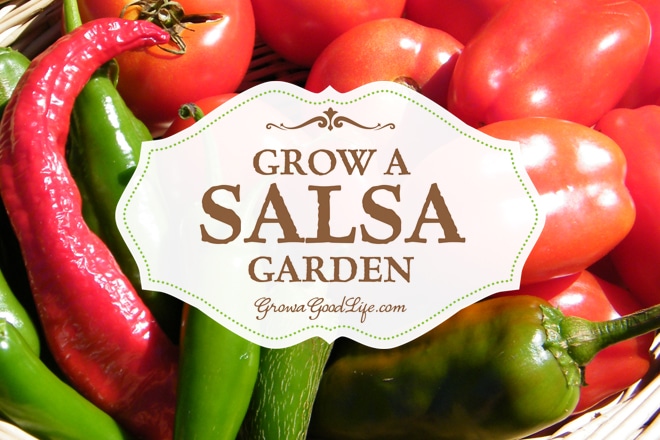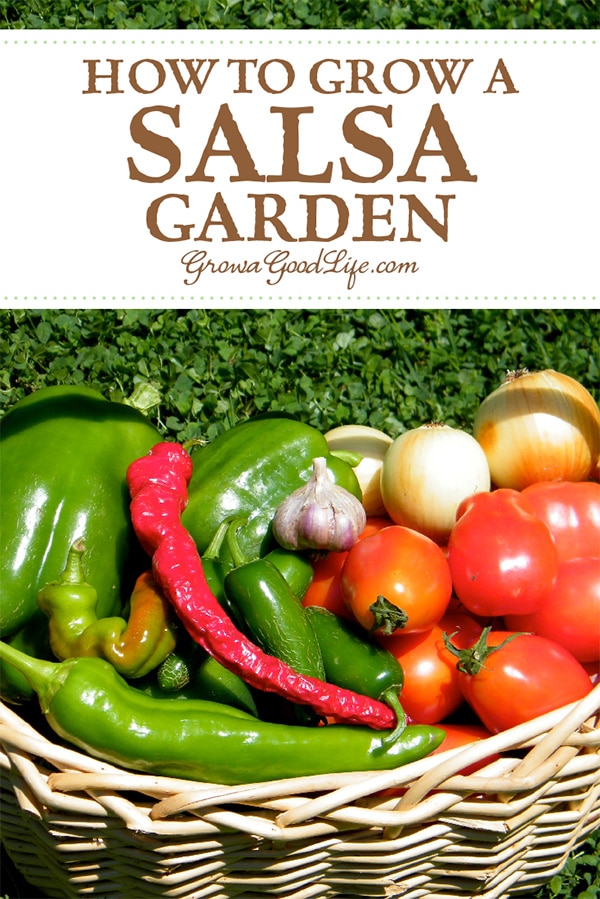To create a salsa garden plan, choose the right varieties of vegetables and herbs that are essential for making salsa at home. A salsa garden can add flavor and freshness to your dishes while providing a satisfying gardening experience.
Growing your salsa ingredients allows you to control the quality and flavors of your produce. Plus, it’s a cost-effective way to enjoy a variety of fresh and nutritious ingredients. We will explore how to plan and design your salsa garden, including the best vegetables and herbs and some tips for successful cultivation.
Whether you have a small balcony or a spacious backyard, you can create a salsa garden that suits your space and tastes. So, let’s get started and make your salsa dreams come true!

Credit: growagoodlife.com
Planning Your Salsa Garden
Are you looking to plan your salsa garden? Get started with a simple and efficient salsa garden plan and enjoy fresh ingredients for your homemade salsa.
Planning Your Salsa Garden
When planning your salsa garden, there are a few important factors to consider. From selecting a suitable location to choosing the right vegetables and herbs, each step plays a crucial role in ensuring a successful harvest of fresh, flavorful ingredients for your homemade salsa. This section will discuss each aspect in detail, providing the necessary information to create a thriving salsa garden right in your backyard.
Selecting a Suitable Location
One of the first steps in planning your salsa garden is selecting a suitable location. The success of your garden largely depends on the amount of sunlight it receives. Most vegetables and herbs commonly used in salsa require full sun, meaning they need at least 6-8 hours of direct sunlight daily. Therefore, choosing a spot in your garden with ample sunlight is important.
In addition to sunlight, you should also consider the soil quality and drainage of the chosen location. Vegetables and herbs thrive in well-drained soil that is rich in organic matter. If your garden soil is heavy clay or sandy, it may be beneficial to amend it with compost or other organic materials to improve its fertility and drainage.
Choosing the Right Vegetables and Herbs
Once you have determined the perfect location for your salsa garden, the next step is to choose the right vegetables and herbs to grow. Fortunately, many of the key ingredients in salsa can be grown easily at home. Some popular choices include tomatoes, peppers, onions, garlic, cilantro, and jalapenos.
When selecting the varieties of these plants, it is important to consider the specific requirements for each. Some tomatoes and peppers may be indeterminate, meaning they continue to grow and produce fruit throughout the growing season, while others may be determinate and make a single harvest. Similarly, some pepper varieties may have different heat levels, so you can choose the ones that suit your taste preferences.
Arranging Plants in Your Garden
After you have chosen the vegetables and herbs for your salsa garden, it is time to arrange them in your garden. Proper spacing is key to ensure that each plant has enough room to grow and receive adequate sunlight and nutrients. Refer to the plant label or seed packet for recommended spacing guidelines.
Consider creating a visual plan or using a simple garden layout diagram to help you arrange the plants in an organized manner. This will also allow you to determine the optimal placement for each plant based on their height and growth habits. For example, taller plants like tomatoes can be placed in the back or against a trellis, while shorter herbs like cilantro can be positioned in the front or along the edges.
Following these steps and properly planning your salsa garden, you can enjoy a bountiful harvest of fresh ingredients that will take your homemade salsa to the next level. So grab your gardening tools and create a vibrant and flavorful garden that will delight your taste buds all season.
Growing And Maintaining Your Salsa Garden
Discover the secrets of successfully growing and maintaining your salsa garden with a well-planned garden layout. Learn how to strategize and organize your planting beds to maximize your salsa harvest.
Preparing The Soil
Before you start planting your salsa garden, preparing the soil properly is essentialegin by clearing the area of any weeds or debris. Next, loosen the soil using a garden fork, ensuring it is well-drained and free from clumps. You can also add organic matter, such as compost or well-rotted manure, to improve the soil’s fertility and structure. Once you have completed these steps, your soil will be ready for your salsa garden.
Planting Seeds Or Seedlings
Once you have prepared the soil, it’s time to start planting your salsa garden. Whether you choose to use seeds or seedlings, make sure you follow the instructions on the seed packets or labels. If you’re starting seeds indoors, use seed trays or small pots filled with seed-starting mix. Remember to keep the soil moist and provide sufficient sunlight until the seedlings can be transplanted outdoors. If you opt for seedlings, gently remove them from their containers and plant them at the recommended spacing in your prepared soil.
Providing Water And Nutrients
Regular salsa watering regularly is crucial for the plant’s growth and productivity. Make sure to water the plants deeply, allowing the soil to absorb the water thoroughly. However, avoid overwatering as it can lead to root rot and other plant diseases. Additionally, consider adding a layer of mulch around your plants to help retain moisture and suppress weeds.
You can feed your plants with organic fertilizers or compost to ensure they receive nutrients. These natural sources of nutrients will help support healthy growth and enhance the flavors of your salsa ingredients. Be sure to follow the instructions on the fertilizer package or consult a gardening expert for the best feeding schedule for your specific plants.
Protecting Your Plants From Pests And Diseases
Protecting your salsa garden from pests and diseases ensures a bountiful harvest. One effective method is regularly inspecting your plants for signs of pests like aphids, caterpillars, or snails. If you notice any pests, use organic pest control methods like neem oil or homemade insecticidal soap to keep them at bay. Additionally, practicing crop rotation can help prevent the buildup of pests and diseases in your salsa garden.
Another way to protect your plants is to provide adequate airflow by spacing them properly. This will help reduce the chances of fungal diseases. If necessary, you can also use organic fungicides as a preventive measure.
By following these steps to grow and maintain your salsa garden, you’ll be on your way to enjoying homegrown ingredients for delicious salsa recipes. Remember to stay consistent with your care routine, and soon, you’ll be reaping the rewards of your efforts!
Harvesting And Using Your Salsa Garden
Now that you’ve made an effort to grow and nurture your salsa garden, it’s time to enjoy the fruits of your labor! Harvesting the ingredients and using them in delicious recipes is the best part. This section will discuss how to know when to harvest and preserve salsa ingredients and share some mouthwatering recipes to help you make the most of your homegrown goodies.
Knowing When To Harvest
Harvesting your salsa garden at the right time is crucial for the best flavor and freshness. Here are some indicators to help you determine when each ingredient is ready to be picked:
| Ingredient | Harvesting Time |
|---|---|
| Tomatoes | When they are fully ripe and have a vibrant color. |
| Peppers | When they have reached the desired size and color. |
| Onions | When the tops start to yellow and fall over naturally. |
| Cilantro | When the leaves are large and fragrant before it bolts. |
Remember, handling your harvested ingredients carefully is essential to prevent bruising or damage so you can enjoy the best quality salsa.
Preserving Salsa Ingredients
If you have abundant salsa ingredients from your garden, preserving them ensures you can enjoy summer’s taste all year round. Here are some simple methods to protect your salsa essentials:
- You can canning tomatoes and peppers in a homemade salsa recipe. This way, you can enjoy your garden-fresh salsa even in the colder months.
- Freezing is another great option for storing your salsa ingredients. Chop the tomatoes, peppers, and onions into desired sizes and freeze them separately in airtight containers or freezer bags.
- If you have an abundance of cilantro, you can dry it by hanging the stems upside down in a well-ventilated area. Once dried, gently separate the fragrant leaves from the stems and store them in an airtight container.
By preserving your salsa ingredients, you can savor the flavors of your garden throughout the year, long after the growing season ends.
Delicious Recipes Using Your Homegrown Ingredients
The exciting part begins – transforming your freshly harvested salsa ingredients into mouthwatering recipes. Here are a few delectable suggestions that will make your taste buds dance:
- Fresh Tomato Salsa: Combine diced tomatoes, chopped onions, minced garlic, cilantro, lime juice, and salt for a refreshing salsa dip.
- Spicy Pepper Salsa: Mix diced peppers, onions, tomatoes, jalapeños, lime juice, and a pinch of cumin for a fiery salsa to accompany your favorite Mexican dishes.
- Cilantro Lime Chicken: Marinate chicken breasts with lime juice, minced garlic, chopped cilantro, salt, and black pepper. Grill for a citrusy and herby delight.
These are just a few examples to get you started. Feel free to experiment with your homegrown ingredients and create signature salsa recipes!

Credit: growagoodlife.com
Frequently Asked Questions Of Salsa Garden Plan
How Do I Start A Salsa Garden?
To start a salsa garden, choose a sunny location, prepare the soil by removing weeds and adding compost, select tomato, pepper, onion, and cilantro varieties, and plant them at the right depth. Water regularly, fertilize as needed, and harvest the fresh ingredients to make delicious salsa at home.
What Are The Best Tomato Varieties For Salsa?
The best tomato varieties for salsa include Roma, San Marzano, and Ace varieties. These tomatoes are firm, meaty, and have a rich flavor, making them perfect for salsa recipes. Choose determinate varieties if you prefer all the tomatoes ripening at once or indeterminate if you want a continuous harvest.
Can I Grow Salsa Ingredients In Containers?
You can grow salsa ingredients like tomatoes, peppers, onions, and cilantro in containers. Select suitable container sizes, ensure they have drainage holes, use high-quality potting soil, and provide adequate water and sunlight. Container gardening allows you to grow salsa ingredients even in limited spaces like balconies or patios.
Conclusion
Creating your salsa garden is a rewarding and sustainable way to enjoy fresh and flavorful ingredients at home. By following a simple garden plan and selecting the right varieties of tomatoes, peppers, and herbs, you can cultivate a thriving garden that will provide you with abundant ingredients for delicious homemade salsa.
With a little care and attention, your salsa garden will flourish and delight your taste buds all season long. So, get started and get ready to enjoy the vibrant flavors of homemade salsa straight from your garden.

